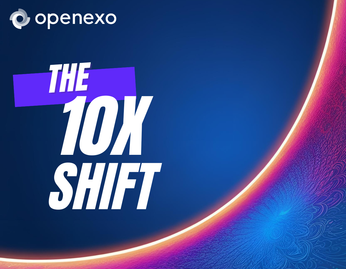
From Linear to Exponential: Transform Your Business for 10x Growth
Discover how to shift your business from linear to exponential growth, leveraging technology and agile methods for transformative success. Embrace ExO principles to achieve up to 40x higher returns and revolutionize your organization.
Are you ready to transform your organization from linear to exponential? Discover how embracing exponential growth can revolutionize your business. In today's rapidly evolving business landscape, traditional linear organizations are struggling to keep up. It's time to shift from step-by-step methods and top-down management to a model that thrives on agility and innovation. Learn more about the challenges of linear organizations in this insightful chapter.
Understanding Linear Organizations
Linear organizations are characterized by their reliance on sequential processes, hierarchical structures, and a focus on ownership. Historically, value was generated through the ownership of assets, leading to a focus on slow, steady progress. However, this approach, while effective in the past, is becoming obsolete as technology disrupts traditional business models. Dive deeper into the concept of moving beyond arithmetic in this section.
The traditional New Product Development (NPD) process, akin to cooking a meal from scratch, follows a linear path from idea generation to commercialization. This method, endorsed by the Product Development and Management Association (PDMA), can be slow and cumbersome, often missing out on the rapid innovation cycles that are crucial in today's market.
Large corporations often adopt a matrix structure, which can be compared to a complex web of interconnected teams. While designed to manage complexity, these structures can hinder innovation due to isolated information and multiple reporting lines. The pursuit of cost-saving through size has driven the growth of globalized corporations, but at the cost of flexibility. These organizations often prioritize size over agility, leading to a bloated "immune system" that resists change and stifles innovation. Explore the impact of matrix organizational structures on innovation in this scholarly article.
The Shift to Exponential Thinking
Embracing exponential growth requires a fundamental shift in organizational mindset. Exponential Organizations (ExOs) leverage technology and agile methodologies to drive transformative growth. As noted in the first edition of "Exponential Organizations,"
"As technology brings us a world of abundance, access will triumph over ownership."This shift from ownership to access models is crucial for organizations aiming to thrive in the face of rapid change. Understand the pitfalls of getting lost in the matrix with this detailed analysis.
Organizations that have adopted ExO principles report impressive performance metrics: 6.8x higher profitability, 40x higher shareholder returns, 11.7x better asset turnover, and 2.6x better revenue growth. These metrics highlight the potential for exponential growth and the power of ExO methodologies. For more on key performance metrics, see this research.
Real-World Examples
The challenges faced by linear organizations are evident in real-world examples. Yahoo's linear matrix structure hindered its ability to innovate, leading to delayed product launches and lost competitive advantages. Similarly, Google struggled with the delayed launch of Google+, illustrating the limitations of linear thinking even in tech giants. For examples of organizations transitioning from linear to exponential thinking, check out this insightful article.
The global lockdown due to the COVID-19 pandemic further highlighted the need for organizational agility. Many organizations realized that employees could work effectively from remote locations, prompting a shift in thinking about the nature of work and collaboration. Kelley Rowe, co-founder of ExO Africa, noted this shift, emphasizing the potential for remote work to drive efficiency and innovation. Learn more about agility in business transformation with this McKinsey report.
Even established institutions like the Vatican are recognizing the need for change. In 2017, the Vatican invited Salim Ismail, co-author of "Exponential Organizations," to run a workshop for senior leaders, highlighting the universal challenge of linear thinking across sectors. For more on the cost of size, read this section.
Implementing ExO Principles
Transitioning to an ExO model involves practical steps that organizations can take to embrace exponential growth. Here's a step-by-step guide to get started:
- Assess Current State: Evaluate your organization's current structure and processes to identify areas for improvement.
- Embrace Technology: Leverage AI, blockchain, VR/AR, and IoT to enhance scalability and innovation.
- Shift to Access Models: Move from ownership to access models to align with the principles of abundance thinking. Learn more about abandoning linear thinking in this chapter.
- Foster Agility: Encourage a culture of experimentation and rapid iteration to drive continuous improvement.
- Implement ExO Attributes: Focus on attributes like Autonomy, Scalability, and Purpose to transform your organization.
Key Takeaways and Questions
- What are the main characteristics of linear organizations?
Linear organizations are characterized by sequential processes, hierarchical structures, and a focus on ownership and slow, steady progress.
- How do matrix structures impact innovation within large corporations?
Matrix structures can hinder innovation due to isolated information and multiple reporting lines, reducing agility and flexibility.
- What are the benefits and drawbacks of pursuing economies of scale?
Economies of scale can lead to cost efficiencies but often result in reduced flexibility and agility, hindering innovation.
- How did the global lockdown influence organizational thinking about remote work?
The global lockdown highlighted the potential for remote work, prompting organizations to rethink traditional models and embrace more flexible work arrangements.
- What are some real-world examples of organizations struggling with linear thinking?
Yahoo and Google are examples of companies that faced challenges with linear organizational structures, leading to delayed product launches and lost competitive advantages.
- How can organizations transition from linear to exponential thinking?
Organizations can transition by embracing ExO principles, focusing on agility, leveraging technology, and shifting from ownership to access models.
- What are the key performance metrics for organizations implementing ExO principles?
Organizations implementing ExO principles report 6.8x higher profitability, 40x higher shareholder returns, 11.7x better asset turnover, and 2.6x better revenue growth.
- What role do established institutions like the Vatican play in the broader discussion on organizational transformation?
Established institutions like the Vatican illustrate the universal challenge of linear thinking and the need for transformation across all sectors.
Final Thoughts
The journey from linear to exponential thinking is not without its challenges, but the potential rewards are immense. By embracing the principles of Exponential Organizations, business professionals, consultants, changemakers, and C-suite executives can drive transformative growth and stay ahead in a rapidly changing business landscape. For more on Exponential Organizations, visit the Exponential Organizations wiki.
Explore the concepts of Exponential Organizations further and consider how you can implement these strategies in your own organization. The future belongs to those who can think and act exponentially.
- Embrace exponential growth to revolutionize your business.
- Shift from ownership to access models to align with abundance thinking.
- Implement practical steps to transition to an ExO model.
- Recognize the universal challenge of linear thinking across sectors.
ExO Insight Newsletter
Join the newsletter to receive the latest updates in your inbox.









